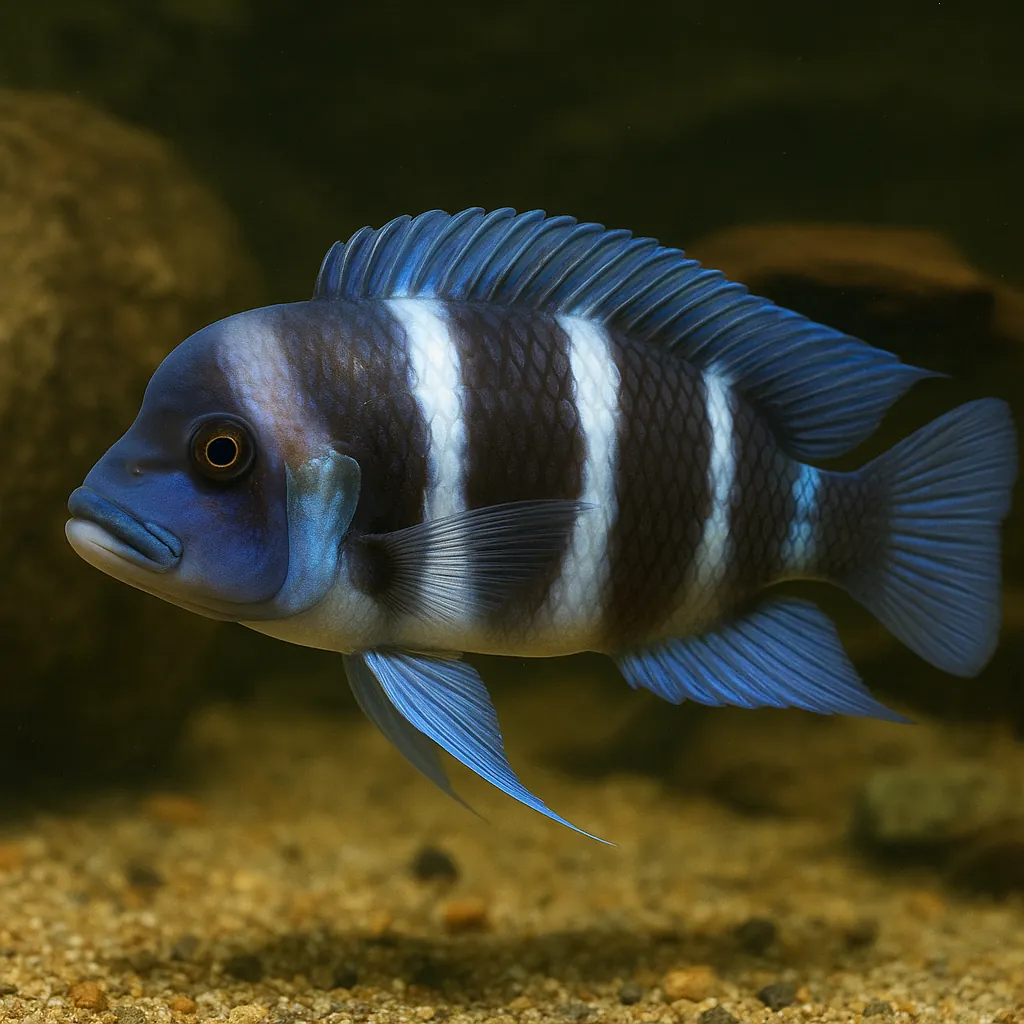
Frontosa cichlid
Introduction
The Frontosa cichlid, scientifically known as Cyphotilapia frontosa, is a captivating freshwater fish native to Lake Tanganyika in East Africa. Renowned for its striking appearance, this species features bold vertical stripes and a prominent cranial hump, especially in mature males. Its calm demeanor and unique aesthetics make it a favorite among aquarists seeking a distinctive addition to their tanks. While Frontosas are relatively peaceful compared to other cichlids, they do require specific care conditions, making them more suitable for aquarists with some experience.
What makes the Frontosa cichlid stand out in an aquarium?
Its combination of size, unique coloration, and the characteristic cranial hump gives the Frontosa a regal presence, often becoming the centerpiece of large aquariums.
Is the Frontosa cichlid suitable for beginners?
Due to their specific care requirements and potential size, Frontosas are better suited for aquarists with some prior experience in fishkeeping.
Care and Environment
Proper care for Frontosa cichlids involves attention to tank size, water parameters, diet, and tank setup to ensure their well-being.
What is the minimum tank size for a Frontosa cichlid?
A single Frontosa requires a minimum tank size of 265 liters to accommodate its growth and swimming needs. For groups, a larger tank is essential to provide ample space and reduce territorial disputes.
What are the ideal water parameters for Frontosa cichlids?
Frontosas thrive in water temperatures between 24°C and 26°C, with a pH range of 7.5 to 8.5. Maintaining water hardness between 10 to 20 dGH is also recommended to replicate their natural habitat conditions.
Filtration should be robust to handle the bioload of these large fish, ensuring clean and well-oxygenated water. Moderate lighting is sufficient, as Frontosas are accustomed to dimmer environments in the wild.
Diet-wise, Frontosas are carnivorous, feeding on smaller fish and crustaceans in their natural habitat. In captivity, they accept a variety of foods, including sinking pellets, frozen or live foods like krill, prawns, mysis shrimp, and earthworms. It's advisable to feed them two to three times daily, offering only what they can consume in a few minutes to prevent overfeeding and maintain water quality.
When setting up the tank, incorporate a sandy substrate with ample rock formations to create caves and hiding spots, mimicking their natural environment. While plants can be added, ensure they are hardy species, as Frontosas may uproot delicate plants during their activities.
Are Frontosa cichlids sensitive to water changes?
Yes, they can be sensitive to sudden changes in water parameters. It's crucial to perform regular, gradual water changes to maintain stability and avoid stressing the fish.
Origin and Habitat
Frontosa cichlids are endemic to Lake Tanganyika, the world's second-largest freshwater lake, located in East Africa. They inhabit the deeper regions of the lake, typically found at depths ranging from 30 to 50 meters. These areas are characterized by rocky substrates and minimal vegetation, providing ample hiding spots and territories. The water in Lake Tanganyika is known for its high mineral content, resulting in hard and alkaline conditions, which are essential to replicate in captivity for the health of Frontosas.
Why is it important to replicate Lake Tanganyika's conditions in an aquarium?
Replicating these conditions ensures the health and longevity of Frontosas, as they have evolved to thrive in such an environment.
Temperament and Compatibility
Frontosa cichlids are relatively peaceful compared to other cichlid species but can exhibit territorial behavior, especially during breeding. They are best kept in groups, ideally with one male and several females, to establish a natural hierarchy and reduce aggression. Suitable tank mates include other large, non-aggressive fish that can tolerate similar water conditions, such as certain species of catfish and other Lake Tanganyika cichlids. It's essential to avoid housing them with small fish, as Frontosas may view them as prey.
Can Frontosa cichlids be kept with other cichlid species?
Yes, they can coexist with other large, peaceful cichlids from Lake Tanganyika, provided the tank is spacious enough to accommodate all inhabitants without overcrowding.
How can aggression be minimized in a tank with Frontosa cichlids?
Providing ample space, hiding spots, and maintaining a proper male-to-female ratio can help reduce aggression and promote a harmonious environment.
Interesting Facts
Frontosa cichlids are mouthbrooders, with females carrying fertilized eggs and fry in their mouths for several weeks to protect them from predators. This unique reproductive behavior adds to their appeal among aquarists. Additionally, they have a slow growth rate, often taking several years to reach their full size, which requires patience from their keepers. Their lifespan can extend up to 25 years in captivity, making them a long-term commitment for dedicated aquarists.
Why do Frontosa cichlids have a cranial hump?
The cranial hump, more pronounced in males, is believed to play a role in mating displays and establishing dominance within groups.
How long does it take for a Frontosa cichlid to reach full size?
Due to their slow growth rate, it can take several years for a Frontosa to attain its maximum size, emphasizing the need for long-term care planning.
Sources
All information in this article has been gathered from the following reputable sources:
Overview
Recommended Tank Size 105.7 Gallons (for groups of 6 or more) |
Minimum Group Size 1 |
Minimum Tank Volume 70 Gallons |
Maximum Adult Length 15.7 inches |
Average Adult Length 11.8 inches |
Shoaling (6+ required) Yes |
Preferred Water Type Hard, alkaline freshwater |
Temperature Range (°C) 24–26 |
pH Range 7.5–8.5 |
Water Hardness (dGH) 10–20 |
Typical Lifespan (years) 25 years |